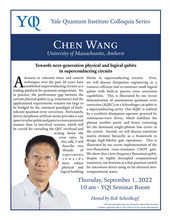Towards next-generation physical and logical qubits in superconducting circuits
Advances in coherent times and control techniques over the past 20 years have established superconducting circuits as a leading platform for quantum computation. Yet in practice, the performance gap between the current physical qubits (e.g. transmons) and the applicational requirements remains too large to be bridged by the canonical paradigm of fault-tolerant quantum error correction. Fortunately, driven Josephson artificial atoms provides a vast space to tailor qubits and gates in a more protected manner than in two-level systems, which will be crucial for curtailing the QEC overhead and scaling down the error rates.
In this talk, I will describe two threads of experiments towards more robust physical and logical building blocks in superconducting circuits. First, we will discuss dissipation engineering as a resource-efficient tool to construct small logical qubits with built-in passive error correction capabilities. This is illustrated by our recent demonstration of autonomous quantum error correction (AQEC) on a Schrodinger cat qubit in a superconducting cavity. Our AQEC is realized by a synthetic dissipation operator powered by continuous-wave drives, which stabilizes the photon number parity and hence correcting for the dominant single-photon loss errors in the system. Second, we will discuss transition matrix element hierarchy as a framework to design high-fidelity gate operations. This is illustrated by our recent implementation of the two-fluxonium cross-resonance CNOT gate. We show that a low-frequency fluxonium qubit, despite its highly decoupled computational transition, can function as a fast quantum switch for microwave drives using its far-detuned non-computational states.
